As urban spaces grow crowded and shoreline real estate becomes scarce, a new form of water-based hospitality is making waves — the floatel.
Short for floating hotel, a floatel combines luxury, mobility, and innovation in a single floating structure. From tranquil backwaters to bustling riverfronts, floatels are transforming how we experience travel, tourism, and even urban leisure.
At AIPL, we design and deliver complete floating infrastructure systems that make floatel development not just possible — but practical, scalable, and sustainable.

A floatel is a fully functioning accommodation facility constructed on a floating platform, designed to stay anchored on rivers, lakes, reservoirs, or coastal waters.
Unlike traditional hotels, floatels:
Floatels can range from single-suite floating cottages to large-scale floating hotels with restaurants, lounges, and event spaces.
In cities where space is a challenge, floatels unlock the untapped potential of waterbodies without disturbing the land ecosystem.
Modern floatels often use solar power, sustainable waste systems, and low-impact mooring — ideal for green tourism and eco-sensitive regions.
From sunrise views on a calm lake to dining under the stars above water, floatels offer a stay experience that traditional hotels simply can’t match.
Thanks to modular pontoons and platforms, floatels can expand with demand or be relocated seasonally — perfect for tourism boards, resorts, and waterfront developers.
India’s rich network of rivers, lakes, and backwaters makes it a perfect setting for floatels.
With years of experience in floating infrastructure across tourism, transport, events, and construction, AIPL delivers:
We assess water depth, flow, access points, and permissions to ensure the location is suitable for a floatel.
Our floating systems are modular, durable, and customizable — capable of handling various load and layout requirements.
From design and fabrication to installation and mooring, AIPL handles the complete floatel setup.
We guide clients through environmental, IWAI, tourism, and urban development approvals where needed.
| Challenge | AIPL’s Response |
| Water stability | Engineered mooring and anchoring systems |
| Utility access | Hybrid power + solar + shore connections |
| Seasonal variation | Floating gangways and modular anchoring |
| Regulatory compliance | Support across departments and clearances |
The floatel is more than just a floating hotel — it’s a bold step toward sustainable, innovative, and experiential hospitality. As governments and private developers look to activate underused waterbodies, floatels present an ideal solution that blends architecture, nature, and tourism.
At AIPL, we’re proud to be powering this floating future — one project at a time.
Floating infrastructure — whether it’s for tourism, transport, or industrial use — is more than just pontoons and platforms. To function safely and efficiently, these structures depend on a set of key accessories that enhance usability, protect against wear, and ensure safe movement of people and vessels.
Among the most critical accessories in any floating system are gangways, bollards, and fenders.
In this blog, we’ll break down their individual roles, types, and why they’re considered essential components of any robust floating infrastructure project.
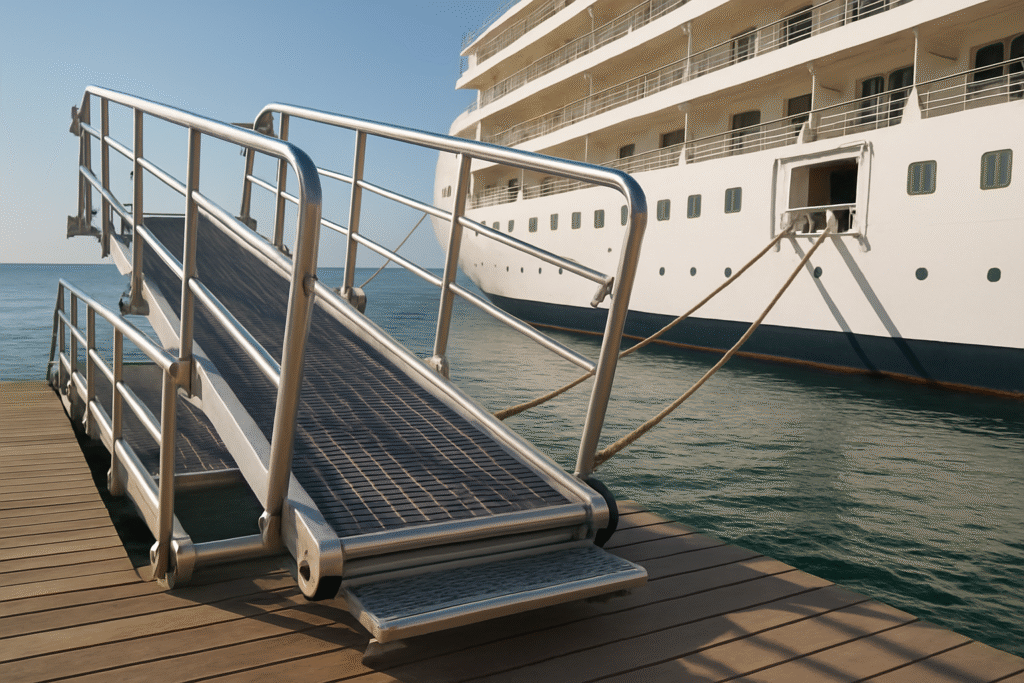
Gangways are bridge-like structures that provide safe, walkable access between the floating platform and the shore. They are typically hinged or flexible to accommodate tidal or seasonal water level changes.
Without a well-designed gangway, floating systems are difficult to access, especially for elderly users, maintenance teams, or during emergency situations.
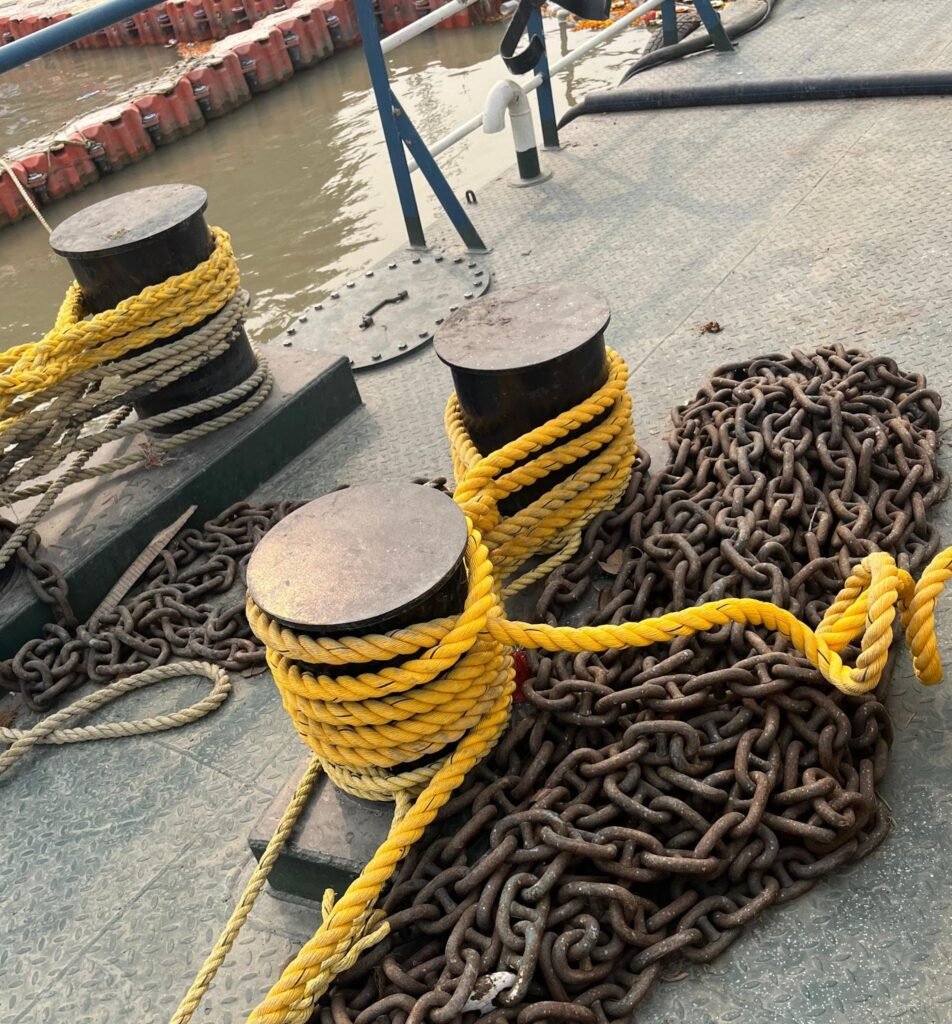
Bollards are short vertical posts installed on floating structures or nearby land, used to tie or moor boats and vessels securely in place.
Improper mooring can lead to structural damage, collisions, or even safety hazards for passengers. Bollards ensure that boats stay docked even in rough water.

Fenders are cushioning devices installed along the edge of floating platforms or docks to absorb the impact from boats during berthing or accidental contact.
A well-fendered floating structure can handle frequent vessel traffic without sustaining long-term damage — critical for busy terminals and tourism jetties.
Floating infrastructure is only as strong as its weakest component. While pontoons and platforms may grab the spotlight, it’s the supporting accessories — gangways, bollards, and fenders — that quietly do the heavy lifting in the background.
At AIPL, we specialize in designing and installing complete floating systems — including all critical accessories — tailored to your project’s specific waterbody and usage needs.
Q1. What is Acquafront Infrastructure Pvt. Ltd. (AIPL), and what does the company
specialize?
Ans: Acquafront Infrastructure Pvt. Ltd. (AIPL) is a pioneering company specializing in the
design, manufacturing, and installation of advanced floating infrastructure systems for
maritime and inland waterways. Since 2018, AIPL has been delivering IP-driven and
sustainable turnkey solutions tailored for sectors such as water supply, renewable energy,
tourism, dredging, defence, and transportation.
Q2. What types of floating structures does AIPL offer?
Ans: AIPL offers four major types of modular floats tailored for diverse industrial
applications:
Q3. Where are your corporate office and manufacturing facilities located?
Ans:
Corporate Office:
3rd Floor, Tower-C, Office No. C-320, I-THUM, Plot No. A-40, Sector-62, Noida, Gautam
Buddha Nagar, Uttar Pradesh – 201301
Q4. Are your designs compliant with Indian standards or certified by third-party
institutions?
Ans: Yes, all our designs adhere to applicable Indian Standards such as IR-Class, IS 800, IS
456, IS 875, etc. Additionally, we support third-party design vetting through agencies like IR
Class, IITs, and Naval consultants as required.
Q5. Who are some of your key clients and past projects?
Ans: AIPL has delivered floating infrastructure solutions for prestigious clients such as:
Q6. How can I get in touch with AIPL for a new project or partnership?
Ans: You can submit your inquiry directly through our website’s contact form:
https://acquainfra.com/enquiry
In the world of floating infrastructure, stability is everything.
Whether it’s a floating jetty, solar plant, or modular event platform, the strength and safety of any floating system ultimately depend on how well it is moored. Mooring systems — the anchor and tether mechanisms that keep floating structures in place — are the silent backbone of every successful floating installation.
In this blog, we’ll explore the different types of mooring systems used in floating infrastructure projects, when and where they are applied, and how to choose the right one based on site conditions and use cases.

Floating infrastructure is constantly at the mercy of natural forces — wind, waves, currents, and water level fluctuations. A poorly moored system can drift, tilt, or even capsize, leading to costly damage or operational downtime.
A well-engineered mooring layout:

Floating infrastructure commonly uses a mix of the following mooring systems, depending on waterbody type (river, lake, coastal), project scale, and operational requirements.
What It Is:
Vertical steel or concrete piles are driven into the waterbed, and the floating structure slides up and down along these piles with water level changes.
Best For:
Advantages:
Limitations:
What It Is:
Heavy-duty chains or steel cables connect the floating structure to anchors or deadweights laid on the waterbed.
Best For:
Advantages:
Limitations:
What It Is:
Massive concrete blocks (deadweights) hold the floating structure in place via tensioned cables or ropes.
Best For:
Advantages:
Limitations:
What It Is:
Removable vertical poles (spuds) are inserted through sleeves in the floating platform and anchored into the riverbed or lakebed.
Best For:
Advantages:
Limitations:
What It Is:
A combination of two or more mooring types — such as pile + chain, or deadweight + spud — depending on project needs.
Best For:
Advantages:
Limitations:
Choosing the right mooring layout isn’t just about anchoring the platform — it’s about ensuring long-term performance.
Here are key factors AIPL engineers consider:
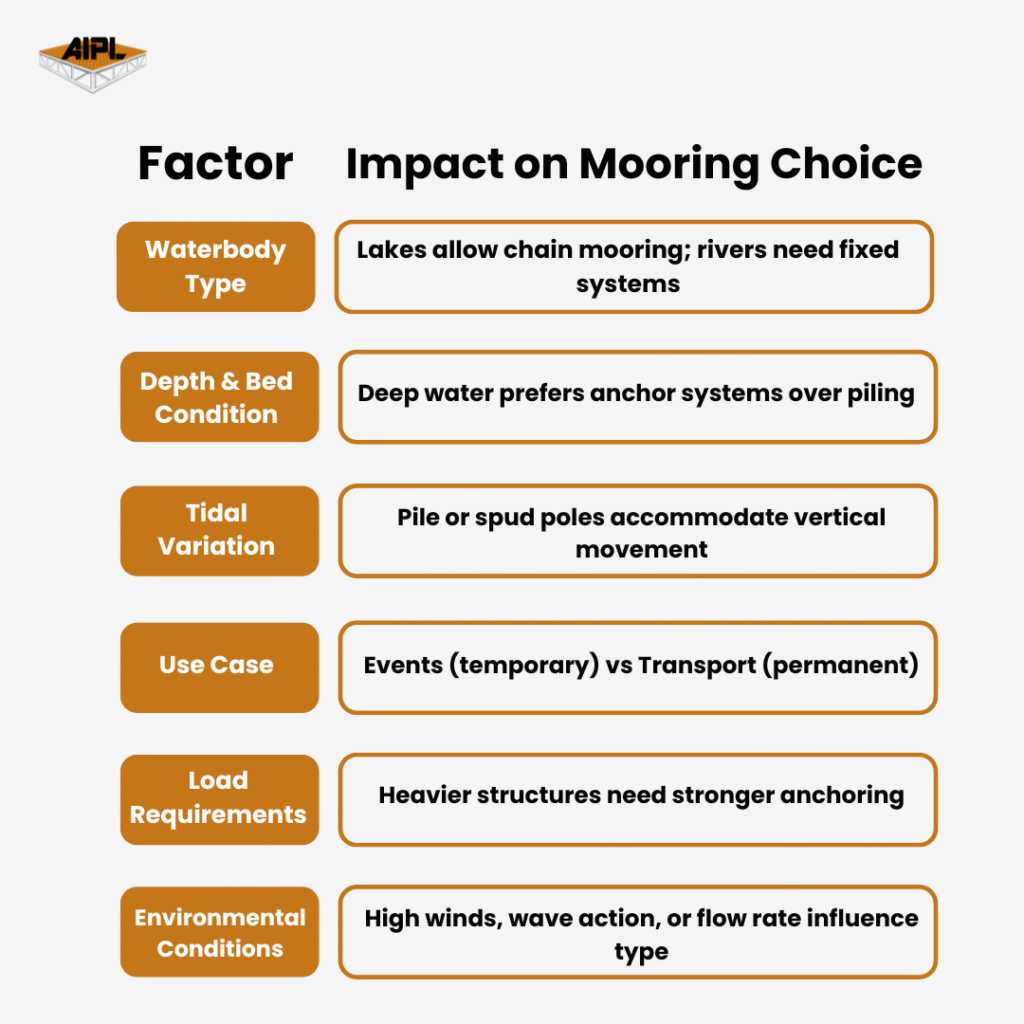
Every floating project begins with a solid foundation — and in water, that foundation is your mooring system.
At AIPL, we engineer custom mooring layouts that consider not just technical viability but also environmental impact, operational goals, and future scalability. Whether it’s a floating jetty, solar plant, or modular barge, our design-first approach ensures that your infrastructure stays safe, stable, and functional — year after year.
🔗 Got a project in mind?
Let’s talk about the right mooring solution for your waterbody.
Contact AIPL for a custom mooring layout consultation.
Q1. What is Acquafront Infrastructure Pvt. Ltd. (AIPL), and what does the company
specialize?
Ans: Acquafront Infrastructure Pvt. Ltd. (AIPL) is a pioneering company specializing in the
design, manufacturing, and installation of advanced floating infrastructure systems for
maritime and inland waterways. Since 2018, AIPL has been delivering IP-driven and
sustainable turnkey solutions tailored for sectors such as water supply, renewable energy,
tourism, dredging, defence, and transportation.
Q2. What types of floating structures does AIPL offer?
Ans: AIPL offers four major types of modular floats tailored for diverse industrial
applications:
Q3. Where are your corporate office and manufacturing facilities located?
Ans:
Corporate Office:
3rd Floor, Tower-C, Office No. C-320, I-THUM, Plot No. A-40, Sector-62, Noida, Gautam
Buddha Nagar, Uttar Pradesh – 201301
Q4. Are your designs compliant with Indian standards or certified by third-party
institutions?
Ans: Yes, all our designs adhere to applicable Indian Standards such as IR-Class, IS 800, IS
456, IS 875, etc. Additionally, we support third-party design vetting through agencies like IR
Class, IITs, and Naval consultants as required.
Q5. Who are some of your key clients and past projects?
Ans: AIPL has delivered floating infrastructure solutions for prestigious clients such as:
Q6. How can I get in touch with AIPL for a new project or partnership?
Ans: You can submit your inquiry directly through our website’s contact form:
https://acquainfra.com/enquiry
Every floating infrastructure project begins long before the first pontoon hits the water.
Whether it's a floating jetty, solar plant, modular barge, or riverfront tourism platform — the success of the project depends on meticulous pre-installation planning. Without proper groundwork, projects risk cost overruns, delays, compliance issues, or even structural failure.
In this blog, we’ve compiled a pre-installation checklist that covers everything from surveys and data collection to approvals and environmental considerations. At AIPL, this checklist forms the backbone of every project we execute.
Before design even begins, the project team must understand the physical and environmental conditions of the site.
A bathymetric survey maps the underwater terrain, while a topographic survey maps the land interface.
Floating platforms may seem “light,” but they often carry people, equipment, utilities, or even vehicles. Knowing these loads is essential for safety.
Every floating installation must align with central and state regulations. AIPL works closely with authorities to ensure full compliance.
Floating infrastructure is seen as a sustainable alternative — but every project must still consider its environmental footprint.
For large-scale, high-traffic, or government-funded projects, a formal Environmental Impact Assessment (EIA) may be mandated.
If the floating structure includes lighting, communication, or O&M systems, plan the service lines in advance.
Before work begins, the logistics team must evaluate:
At AIPL, this is where our modular and pre-fabricated floating systems simplify execution.
Planning is the foundation of performance — and in floating infrastructure, skipping even one step can cost more than just money.
With experience across water pumping, energy, construction, shipping, events, and tourism sectors, AIPL ensures that every project begins with a solid, compliant, and data-driven pre-installation process.
📌 Want a site-specific checklist for your project?
Connect with our team for a customized project feasibility and pre-planning guide.
Q1. What is Acquafront Infrastructure Pvt. Ltd. (AIPL), and what does the company
specialize?
Ans: Acquafront Infrastructure Pvt. Ltd. (AIPL) is a pioneering company specializing in the
design, manufacturing, and installation of advanced floating infrastructure systems for
maritime and inland waterways. Since 2018, AIPL has been delivering IP-driven and
sustainable turnkey solutions tailored for sectors such as water supply, renewable energy,
tourism, dredging, defence, and transportation.
Q2. What types of floating structures does AIPL offer?
Ans: AIPL offers four major types of modular floats tailored for diverse industrial
applications:
Q3. Where are your corporate office and manufacturing facilities located?
Corporate Office:
3rd Floor, Tower-C, Office No. C-320, I-THUM, Plot No. A-40, Sector-62, Noida, Gautam
Buddha Nagar, Uttar Pradesh – 201301
Q4. Are your designs compliant with Indian standards or certified by third-party
institutions?
Ans: Yes, all our designs adhere to applicable Indian Standards such as IR-Class, IS 800, IS
456, IS 875, etc. Additionally, we support third-party design vetting through agencies like IR
Class, IITs, and Naval consultants as required
Q5. Who are some of your key clients and past projects?
Ans: AIPL has delivered floating infrastructure solutions for prestigious clients such as:
India’s rich coastline and extensive network of rivers have long held untapped potential for economic growth. Now, with the government’s push for a sustainable blue economy, floating infrastructure projects are becoming the backbone of this strategy. From floating jetties to floating solar power plants, these projects are unlocking new economic corridors and opportunities for tourism, logistics, clean energy, and maritime trade.
In this blog, we’ll explore how floating infrastructure projects are fueling India’s blue economy, actual project examples, their benefits, and how expert firms like AIPL are actively contributing to this maritime movement.
The blue economy refers to the sustainable use of ocean and waterway resources for economic growth, improved livelihoods, and job creation, while preserving marine ecosystems. It includes:
India, with a 7,500+ km coastline and 111 national waterways, is strategically positioned to lead in this sector.
Floating infrastructure refers to modular or custom-engineered structures built to float on water — rivers, lakes, backwaters, reservoirs, and coastal areas — enabling economic, tourism, energy, and logistical operations where conventional land-based infrastructure is either impractical or environmentally disruptive.
Location: Goa, Maharashtra, Gujarat, and Kerala
Details:
As part of the Sagarmala initiative, multiple floating jetties are being built to support coastal and riverine passenger movement, cargo handling, and tourism. The floating jetty at Captain of Ports, Panjim (Goa) is operational, facilitating better water taxi services and cruise docking. Similar jetties are planned at Haldia (West Bengal) and Vijayawada (Andhra Pradesh) on National Waterway-4.
Significance: Reduces pressure on congested land ports and enhances local economy through tourism.
Location: Khandwa, Madhya Pradesh
Details:
India’s largest floating solar power project under construction — a 600 MW floating solar power plant on the Narmada river’s Omkareshwar reservoir. It will help power nearby villages and industries while conserving land.
Significance: Supports clean energy generation while utilizing unused water surfaces.
Location: Assi Ghat, Varanasi & Ashtamudi Lake, Kerala
Details:
Floating restaurants and houseboats like Alleppey’s luxury floating hotels and Varanasi’s floating cafeteria and multi-cuisine restaurant enhance waterfront tourism while creating new livelihood opportunities for locals.
Significance: Drives cultural, spiritual, and eco-tourism.
Location: Haldia (West Bengal) to Varanasi (Uttar Pradesh)
Details:
The World Bank-supported Jal Marg Vikas Project includes floating terminals, pontoons, and cargo handling facilities along NW-1. Regular container and cargo movement is operational between Haldia, Sahibganj, and Varanasi.
Significance: Shifts bulk cargo from road/rail to waterways, reducing congestion and logistics costs.
Floating Advertising Platforms in Mumbai & Udaipur
Location: Mumbai’s Marine Drive, Udaipur’s Fateh Sagar Lake
Details:
Floating LED boards and event platforms are being deployed for tourism campaigns and festivals. Companies like AIPL have pioneered floating event stages in Rajasthan for Lake Festival and public events.
Significance: Innovative, eco-friendly advertising without occupying prime land space.
Location: Khirkiya Ghat, Varanasi
Details:
World’s first floating CNG filling station built on a 324 sq. m modular mild steel barge by AIPL for GAIL India. Designed to refuel CNG boats and cruises on the Ganga, it operates year-round, even during floods.
Significance: Reduces air, noise, and water pollution—advancing clean mobility and river conservation.
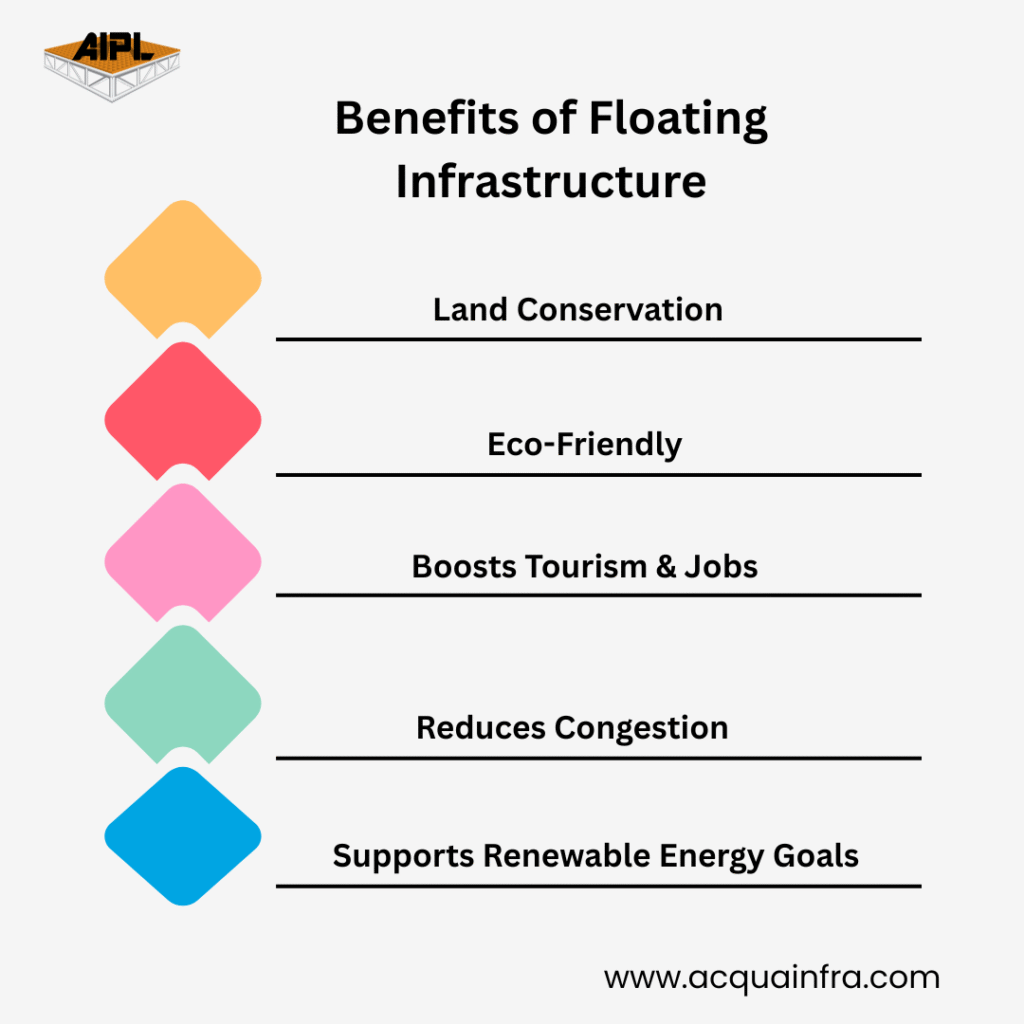
At AIPL (Aqua Infrastructure Pvt. Ltd.), we are actively engaged in floating infrastructure projects contributing to India’s blue economy. Key offerings include:
With our strong presence in Udaipur, Mumbai, Goa, and Varanasi, we have successfully delivered modular pontoons, floating docks, and event platforms for both public and private sector clients.
Q1: What is Acquafront Infrastructure Pvt. Ltd. (AIPL), and what does the company
specialize?
A: Acquafront Infrastructure Pvt. Ltd. (AIPL) is a pioneering company specializing in the
design, manufacturing, and installation of advanced floating infrastructure systems for
maritime and inland waterways. Since 2018, AIPL has been delivering IP-driven and
sustainable turnkey solutions tailored for sectors such as water supply, renewable energy,
tourism, dredging, defence, and transportation.
Q2: What types of floating structures does AIPL offer?
A: AIPL offers four major types of modular floats tailored for diverse industrial
applications:
MS Modular Barges
Steel Integrated Floating Jetty (SIFJ)
GFRC (Glass Fiber Reinforced Concrete) Floating Beams
HDPE Cubes
Q3: Where are your corporate office and manufacturing facilities located?
A: Corporate Office:
3rd Floor, Tower-C, Office No. C-320, I-THUM, Plot No. A-40, Sector-62, Noida, Gautam
Buddha Nagar, Uttar Pradesh – 201301
Q4: Are your designs compliant with Indian standards or certified by third-party
institutions?
A: Yes, all our designs adhere to applicable Indian Standards such as IR-Class, IS 800, IS
456, IS 875, etc. Additionally, we support third-party design vetting through agencies like IR
Class, IITs, and Naval consultants as required.
Q5. Who are some of your key clients and past projects?
A: AIPL has delivered floating infrastructure solutions for prestigious clients such as:
Q6. How can I get in touch with AIPL for a new project or partnership?
A: You can submit your inquiry directly through our website’s contact form:
https://acquainfra.co
A Growing Threat, A Smarter Solution
Floods are no longer unusual; they are seasonal, often monthly, and always expensive. As a digital marketer of pioneering infrastructure brands, I've witnessed how floating platforms are silently redefining survival in flood-risk zones—not as rescue interventions, but as daily infrastructure.
No matter whether it's housing, sanitation, or water pumping, the answer doesn't always reside on land—sometimes it floats.
Climate change has resulted in uncertain weather conditions and increased monsoons.
Urbanization and deforestation have broken up natural water absorption.
Aging infrastructure in most regions can't cope with today's rainfall or runoff.
The World Bank reports that more than 1.5 billion people reside in flood-risk areas—and that figure is growing.
Unlike permanent structures, floating platforms adapt to water levels to avoid submergence or collapse.
For emergency shelters or medical facilities, water pumps, or other purposes, these platforms are modular and portable, providing speedy setup in emergencies.
Constructed from buoyant and corrosion-resistant materials such as Mild steel, HDPE or aluminum, floating platforms do not disrupt ecosystems or need massive land excavation.
They can accommodate:
Floating houses
Emergency medical or rescue facilities
Solar-powered water treatment
Floating pump systems
Not limited to emergencies—these systems can be left in position for months or even years, offering stable solutions in perpetually impacted areas.
Bangladesh: Floating schools and libraries keep education continuous throughout the year in floodplains.
India (Assam, Kerala): Floating bridges and pump pontoons used during monsoon flooding.
Netherlands: Floating neighborhoods constructed as permanent solutions to sea level rise.
Personal Insight: I discovered while doing research on this project a floating village in Cambodia that has homes, schools, and markets adjust with the water. It's not only practical—it's optimistic.
AIPL (Advanced Infrastructure Projects Ltd.) invented floating pump pontoons tailored to meet one of the most urgent issues during floods: the availability of clean, flowing water.
Stability under fluctuating water levels
Long-lasting, anti-corrosive construction materials
Rapid, site-assembled assembly
Low maintenance
Industrial, agricultural, and municipal custom sizes
Industry Tip: Submerged fixed pump stations perish. AIPL's pontoons ride above peril, providing continuous water supply even with loss of ground-level access.
Floating platforms support multiple UN Sustainable Development Goals (SDGs):
Clean Water & Sanitation (Goal 6)
Sustainable Cities (Goal 11)
Climate Action (Goal 13)
They're not only reactive—
they're proactive, adaptive, and green.
An inflatable, module-based building built to float structures like buildings, pumps, or utilities above water, best suited in aquatic or flood-prone areas.
Yes. With a good design and anchoring, they can last for decades as homes, pump stations, or public facilities.
It floats and stabilizes a water pump, enabling water to be pumped efficiently even at fluctuating levels of water or during floods.
Although they are more expensive than conventional structures to implement initially, the cost savings on maintenance, disaster relief, and adaptability in the long term make them inexpensive.
AIPL employs tailored engineering, industrial-grade materials, and a modularity concept, which enables their solutions to be scalable, resilient, and easy to roll out.
Let’s Build Smarter for High-Water Zones.
If you’re planning infrastructure in flood-prone areas, don’t wait for disaster. Start building resiliently—with floating solutions.
👉 Let's Connect! Reach out for consultations, collaborations, or customized floating solutions for your next big idea.
In an era where maritime security and strategic presence are more important than ever, floating infrastructure has emerged as a game-changing solution for defense and strategic maritime zones. From mobile naval bases to emergency supply depots, floating structures are transforming how nations safeguard their coastlines and offshore territories.
In this blog, we’ll explore what floating infrastructure is, its critical applications in defense, benefits, and how expert players like AIPL are contributing to this essential sector.
Floating infrastructure refers to modular or custom-built structures designed to float over water while supporting various activities — from logistics hubs to residential setups. In defense operations, they serve as operational bases, helipads, storage depots, fuel stations, and temporary shelters in strategic waters where land-based infrastructure may not be feasible.
India has over 7,500 km of coastline, and protecting it is a strategic priority. Floating infrastructure allows military forces to establish mobile operational bases at critical points, enhancing:
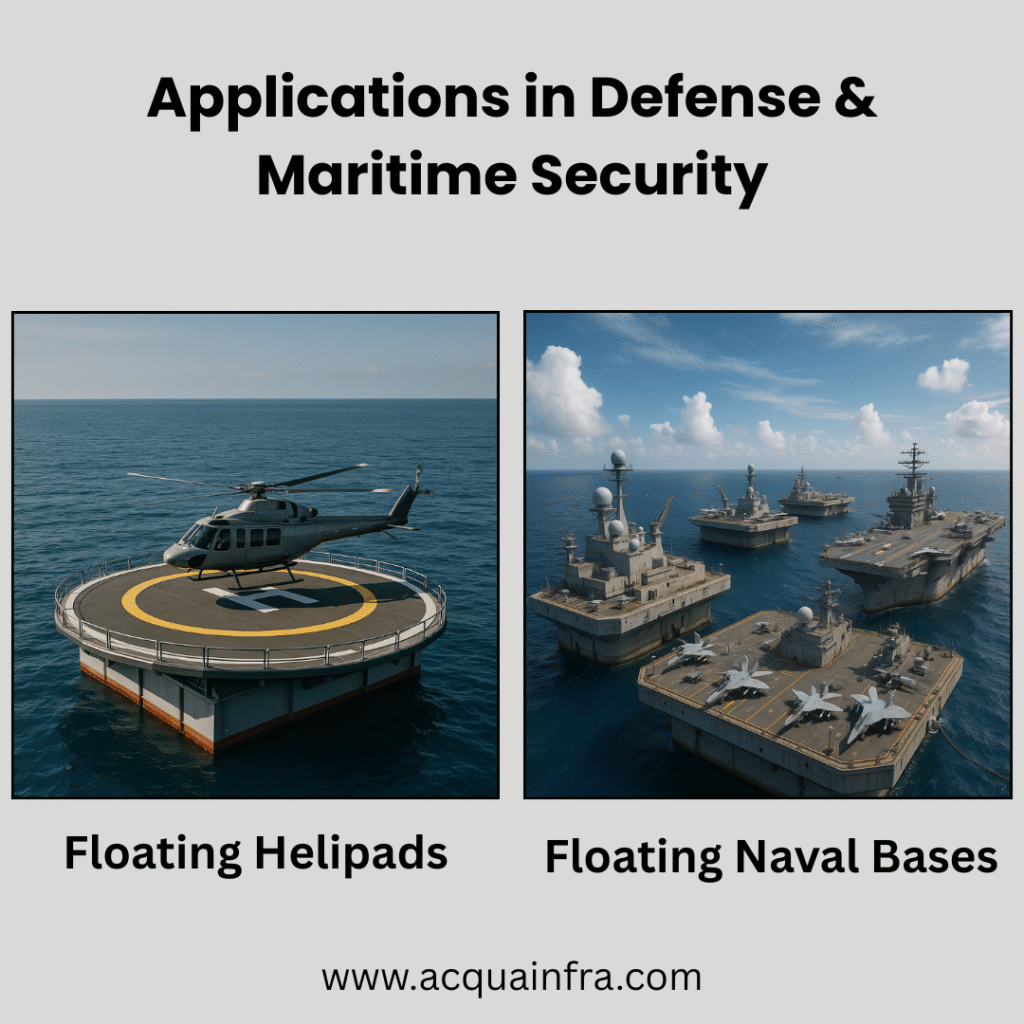
Modular pontoons for quick setup of helipads, landing zones, or staging areas
Tactical Boat Berthing Stations
Used for rapid docking and deployment of patrol or interceptor boats
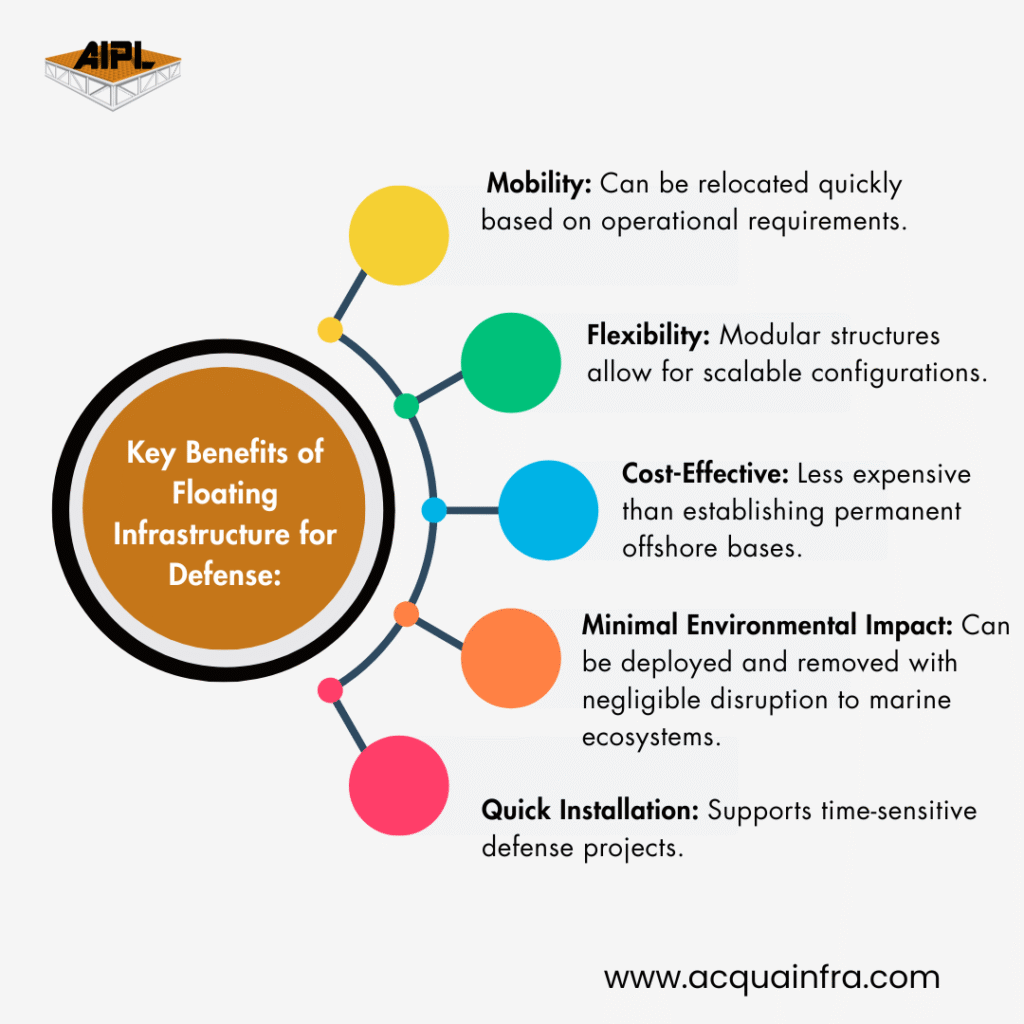
At AIPL (Aqua Infrastructure Pvt. Ltd.), we understand the strategic value of well-designed, reliable floating infrastructure in defense applications. Here’s how we contribute:
With a proven track record in waterways infrastructure and floating platforms, AIPL is equipped to support defense agencies and naval contractors in creating secure, stable, and scalable maritime infrastructure.
Q1: What is Acquafront Infrastructure Pvt. Ltd. (AIPL), and what does the company
specialize in?
Ans: Acquafront Infrastructure Pvt. Ltd. (AIPL) is a pioneering company specializing in the
design, manufacturing, and installation of advanced floating infrastructure systems for
maritime and inland waterways. Since 2018, AIPL has been delivering IP-driven and
sustainable turnkey solutions tailored for sectors such as water supply, renewable energy,
tourism, dredging, defence, and transportation.
Q2: What types of floating structures does AIPL offer?
AIPL offers four major types of modular floats tailored for diverse industrial
applications:
Q3: Where are your corporate office and manufacturing facilities located?
A: Corporate Office:
3rd Floor, Tower-C, Office No. C-320, I-THUM, Plot No. A-40, Sector-62, Noida, Gautam
Buddha Nagar, Uttar Pradesh – 201301
Manufacturing Facility:
Acquafront Infrastructure, Rania Industrial Area, Kanpur, Uttar Pradesh – 209101
Q4: Are your designs compliant with Indian standards or certified by third-party
institutions?
A: Yes, all our designs adhere to applicable Indian Standards such as IR-Class, IS 800, IS
456, IS 875, etc. Additionally, we support third-party design vetting through agencies like IR
Class, IITs, and Naval consultants as required
Q5: Who are some of your key clients and past projects?
A: AIPL has delivered floating infrastructure solutions for prestigious clients such as:
Goa Shipyard Limited
GAIL
MECON
OIL India
VPRPL
ADHPL
OMPL
SPICEJET
PHED Odisha & Rajasthan
In the changing world of today, with its climate change, urbanization, and rising logistical needs colliding, we require more intelligent infrastructure solutions. AcquaCarrier, the Acquafront Infrastructure (AIPL) flagship innovation, is more than a floating barge—it is revolutionary modular marine mobility. Whether shipping cargo in backcountry rivers or bringing relief after a flood, AcquaCarrier is designed to move with purpose, flexibility, and dependability.
The AcquaCarrier Series is an advanced marine shipping system built with AcquaFloat modular pontoon technology. It diverges from conventional, stiff boat designs with containerized, plug-and-play modules that can be shipped and constructed on-site—smashing the clock, reducing costs, and saving logistical woes.
Containerized Design – Simple to transport and fast to build.
Self-Powered – Fully integrated with drive systems.
Plug-and-Play Decks – Flexible for various applications.
Long-Lasting & Economical – Built for repeated, low-maintenance use.
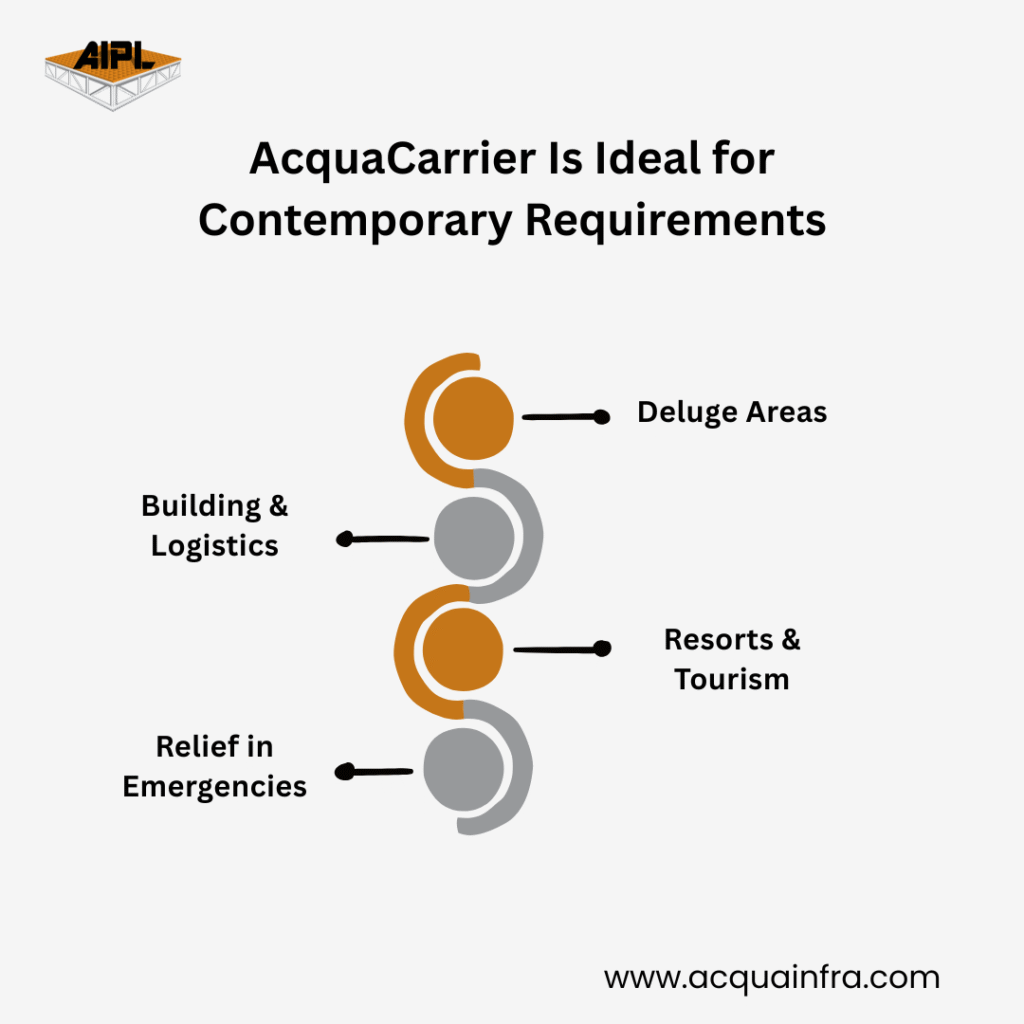
AcquaCarrier excels in disaster zones. Easy to set up and completely self-powered, such platforms can be used as floating command centers, medical facilities, or even mobile food distribution centers during flooding.
Have to ferry heavy equipment through inland waterways for construction work? AcquaCarrier provides adjustable decks ideal for cranes, mixers, or cargo.
From peaceful cruises on lakes to island connection resorts, the carrier can be configured as a high-end shuttle or even a floating event stage.
And when roads are impassable, waterways become lifelines. AcquaCarrier can be an indispensable part of disaster relief by transporting essentials and individuals where they are most required.
AIPL not only creates such advanced carriers but also provides end-to-end project support. They assist clients in deploying AcquaCarriers and floating pump pontoons without any issues, from customized planning to in-field assembly. These systems are especially beneficial in floodwater management, irrigation support, and smart water transport solutions.
AcquaCarrier is ideal for cargo transport, tourism, emergency response, and construction logistics.
Thanks to its containerized design, it can be assembled and deployed within a few days depending on location.
Yes. Its modular, self-powered nature makes it perfect for inaccessible or rural regions.
AIPL offers complete technical planning, modular assembly, floating pontoon integration, and post-deployment support.
Ready to transform your waterway logistics or disaster response?
Get in touch with AIPL and explore AcquaCarrier today.
When it comes to marine and waterfront construction, having a reliable, stable, and adaptable working platform is essential. That’s where construction pontoons come in. These floating platforms are used worldwide for a range of construction projects — from bridges to ports to floating homes. In this blog, we’ll explore what construction pontoons are, their types, benefits, applications, and how a reliable partner like AIPL can assist you in building world-class marine infrastructure.
Construction pontoons are floating platforms used to support heavy equipment, materials, and personnel over water bodies during construction or maintenance projects. Designed to offer stability, durability, and versatility, these structures can be modular or custom-built, depending on the project's scope and site conditions.
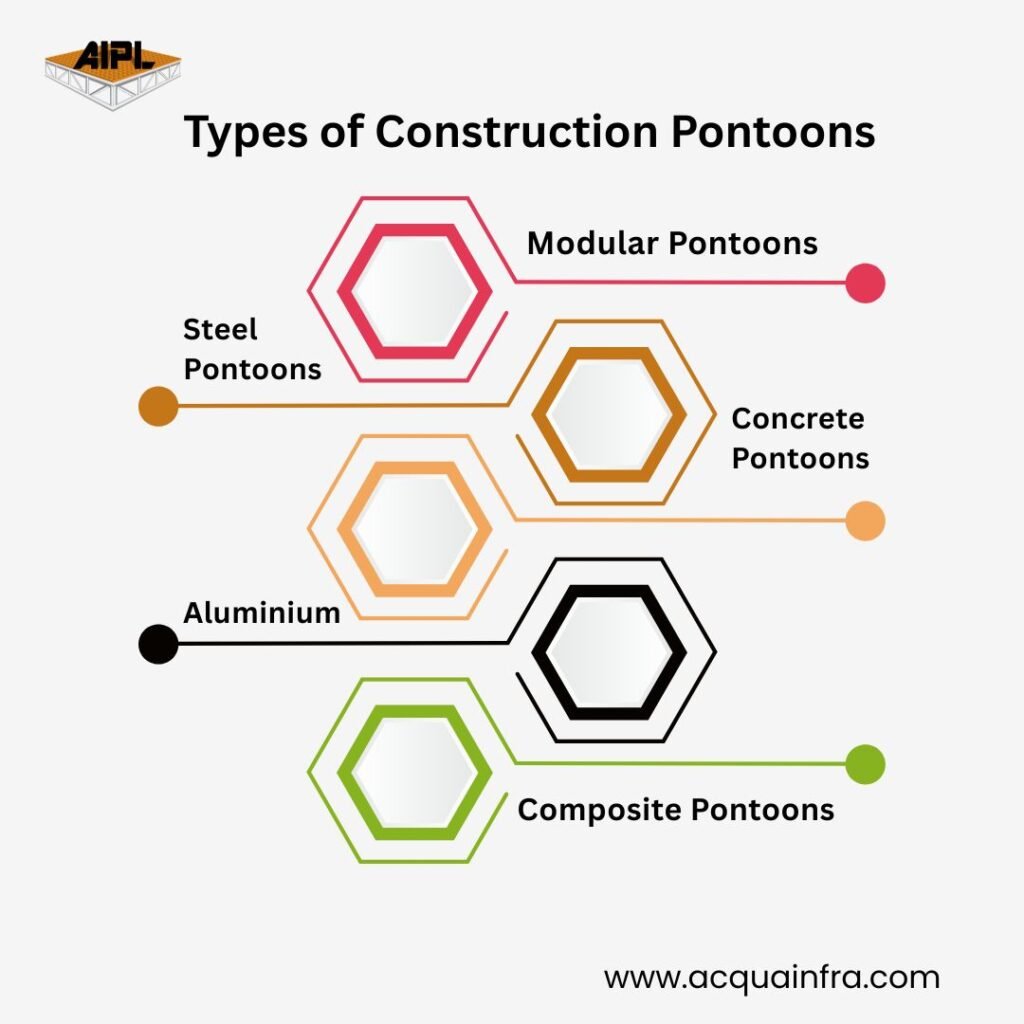
5. Composite or FRP Pontoons
At AIPL (Acqua Infrastructure Pvt. Ltd.), we specialize in designing and supplying top-quality construction pontoons tailored to client needs. With years of experience and an expert engineering team, we provide:
Q1: What is the load capacity of a construction pontoon?
A: It depends on the type — modular pontoons can carry up to 300-500 kg/m², while steel or concrete pontoons can handle several tons.
Q2: Are pontoons reusable for multiple projects?
A: Yes, most modular and steel pontoons are designed for repeated use with easy dismantling and storage.
Q3: How long does it take to install a pontoon platform?
A: Depending on size and type, installation can take a few hours to a couple of days.
Q4: Does AIPL offer customized pontoon solutions?
A: Absolutely! AIPL specializes in designing custom pontoon platforms to match your specific project needs.
Q5: Are pontoons environmentally friendly?
A: Yes — modular pontoons cause minimal disruption to aquatic environments and can be removed without lasting impact.
Ready to Choose the Right Pontoon for Your Project?
Our experts can help you select the most efficient and cost-effective pontoon system for your construction needs.
👉 Contact us today for a free consultation and site assessment!
India is undergoing a massive energy transformation. With the ambitious target to achieve 500 GW of renewable energy by 2030, solar power has emerged as one of the cornerstones of this mission. But with increasing land scarcity, environmental challenges, and a growing thirst for clean energy, India is now exploring innovative ways to harvest solar power — not just from land, but also from water bodies.
Floating Solar Plants and Land-Based Solar Parks have become two primary options for large-scale solar power generation. But which of these is more efficient? And more importantly, which one is better suited for India’s diverse geography and infrastructural needs?
Let’s dive into the details.
Floating Solar Plants, also known as floatovoltaics, are solar power systems installed on the surface of calm water bodies such as lakes, dams, reservoirs, and even abandoned mining pits.
Bonus Benefit: They utilize underused water surfaces while preserving valuable land for agriculture, forestry, or urban development.
Land-Based Solar Parks are the conventional large-scale solar farms most people are familiar with — large, open fields covered with rows of solar panels.
Challenge: They require vast stretches of flat land, which in land-scarce countries like India can lead to conflicts with agricultural, residential, or ecological land use.
| Criteria | Floating Solar Plants | Land-Based Solar Parks |
|---|---|---|
| Land Usage | No land required | Requires large tracts of land |
| Cooling & Efficiency | 5–15% higher due to natural water cooling | Lower due to heat buildup |
| Installation Cost | 20–30% higher initially | Lower |
| Maintenance | Easier (less dust, algae control) | Frequent cleaning, higher manpower |
| Environmental Impact | Reduces evaporation, minimal land disturbance | Land clearing, possible soil degradation |
| Scalability | Limited to available water bodies | Easier in desert or barren lands |
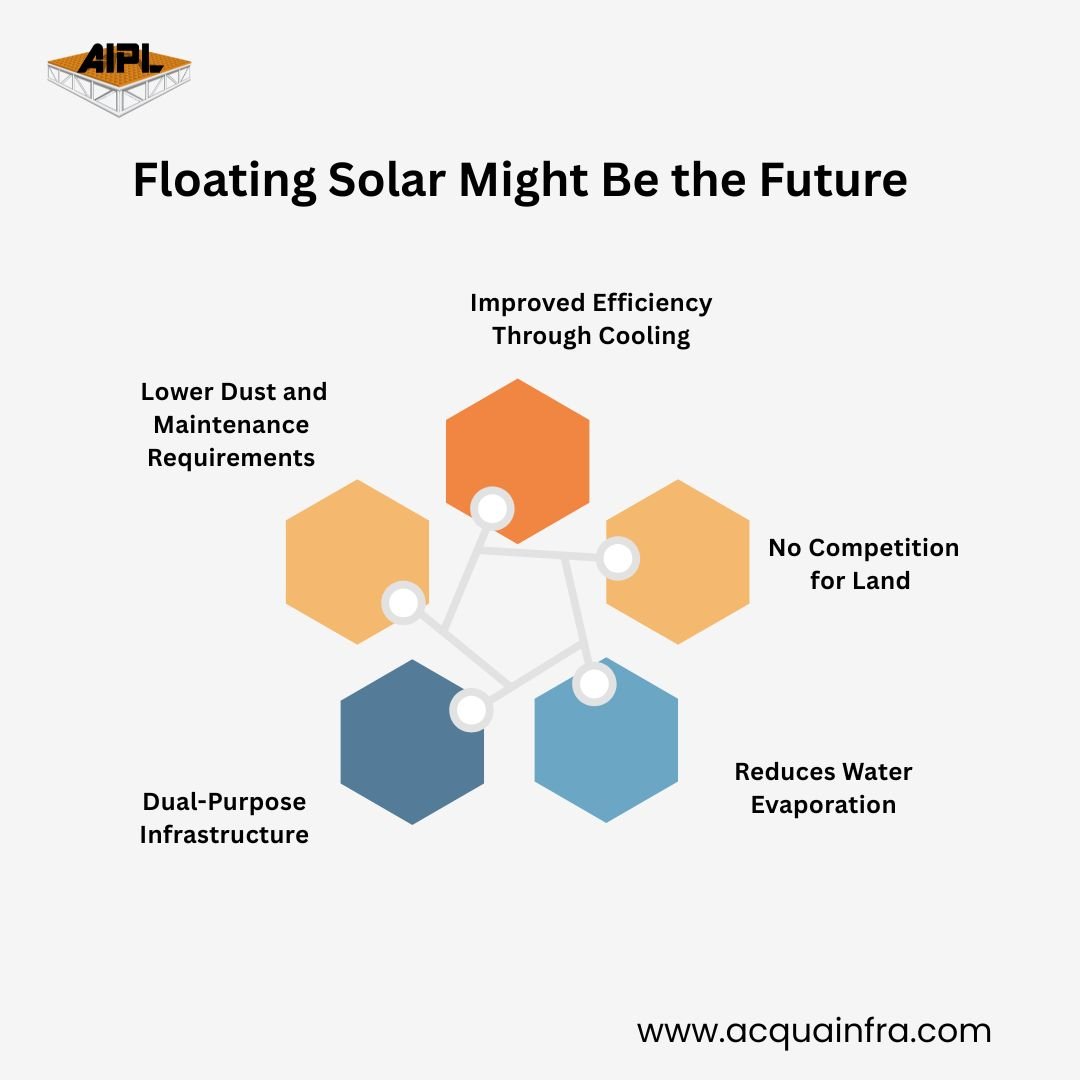
As someone working closely in the maritime and floating infrastructure space, I’ve observed how water bodies are emerging as an untapped asset for renewable energy. Here’s why floating solar is not just a trend — it’s a logical next step.
Solar panels tend to lose efficiency as they heat up, especially in India’s tropical climate. Floating them over water allows the panels to remain cooler, improving their performance by 5–15% compared to land-based systems. This natural cooling effect translates into better energy yields and longer panel life.
Land is scarce, especially in densely populated or agriculturally fertile regions. Floating solar plants sidestep this issue by utilizing idle water surfaces like reservoirs, lakes, and even industrial ponds. This allows land to be preserved for food production, forestry, or urban development.
A lesser-known but valuable benefit is that floating solar panels can significantly reduce evaporation rates in reservoirs and dams — particularly useful in water-stressed regions. According to the International Renewable Energy Agency (IRENA), covering just 10% of a water body’s surface can reduce evaporation by up to 70%.
In regions where water reservoirs exist primarily for drinking water or irrigation, adding solar panels on their surface transforms them into dual-purpose utilities — generating clean energy while conserving water.
Since floating panels are away from dust-laden environments like fields or roads, they require less frequent cleaning. Algae growth on water can also be managed naturally or with occasional cleaning, reducing operational expenses.
India is witnessing a growing number of floating solar projects, driven by state governments and private firms:
This was one of India’s first floating solar plants, installed on the Banasura Sagar reservoir in Wayanad. Although small in size (500 kWp), it demonstrated the technical feasibility of such systems in Indian conditions.
Currently India’s largest floating solar installation, this 100 MW project by NTPC covers a portion of the Ramagundam reservoir and significantly reduces water evaporation while powering nearby areas.
These examples indicate the growing acceptance and adaptability of floating solar infrastructure in India’s energy mix.
As the demand for floating solar infrastructure grows across India, the importance of having experienced, technically sound, and dependable partners becomes crucial. This is where AIPL (Acquafront Infrastructure Pvt. Ltd.) plays a pioneering role.
We at AIPL specialize in delivering integrated, turn-key solutions for floating infrastructure projects — from concept design to commissioning.
In pure numbers, floating solar plants outperform land-based parks by around 5–15% in efficiency, thanks to natural cooling and reduced dust interference.
However, each has its place:
The future of India’s solar story lies in a hybrid approach — combining the vast potential of open lands with the underutilized promise of its water bodies.
Q1. Is floating solar more expensive than land-based solar?
Yes — upfront costs can be 20–30% higher due to floating platforms and anchoring systems. However, higher efficiency and operational savings balance the difference over time.
Q2. Can floating solar panels withstand extreme weather?
Modern floating platforms are engineered to withstand high winds, heavy rains, and fluctuating water levels. Designs follow international maritime safety standards.
Q3. How much water evaporation can floating solar prevent?
Studies show that covering 20–30% of a water body’s surface can reduce evaporation by 50–70% — a game-changer in water-scarce areas.
Q4. Are there risks to aquatic ecosystems?
Properly designed systems allow sunlight penetration and oxygen circulation, minimizing ecological disruption. Some projects have even improved water quality by reducing algae growth.
